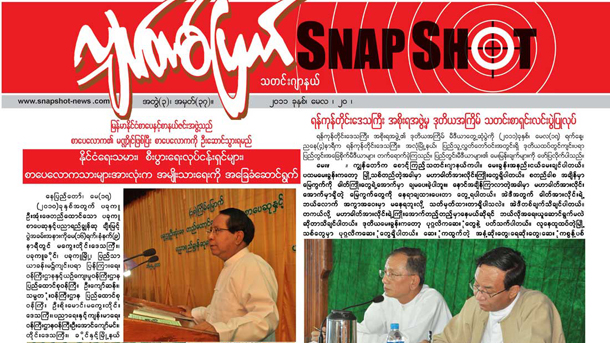Burma’s censorship board ordered the suspension of a leading weekly news journal on Monday for publishing a photo of a woman who was raped and murdered in Arakan State last month, igniting a wave of violence that continues in the remote western region of Burma.
The Press Scrutiny and Registration Division (PSRD), as Burma’s censorship board is known, imposed the indefinite suspension on the Snapshot journal following a warning it issued to all publications to avoid coverage that could add to tensions between Buddhists and Muslims in the state.
“We don’t know how long [the suspension] will remain in place,” the journal’s editor, Myat Khine, told The Irrawaddy on Tuesday. He added that he didn’t think there would be any problem with publishing the photo, which his journal downloaded from the Internet, because it was already so widely circulated.
The journal is the first to be censured since the PSRD warned last week against printing inflammatory coverage of the violence in Arakan State.
On Sunday, Rangoon Division Chief Minister Myint Swe repeated the warning to journalists, telling them that transgressors will be charged under Section 5 (j) of the Emergency Provisions Act and Section 505 (b) of the Burmese Penal Code, which carry sentences of up to nine years imprisonment.
Burma has eased its draconian controls over the media since last year, when a nominally civilian government took office, and the administration of President Thein Sein has said that it will further relax its restrictions on the press. Parliament is expected to introduce a new law of media in the near future.
However, Myat Khine disputed the government’s claims that it is moving toward greater openness. “It is very clear that nothing has changed and that we are not getting any closer to democracy,” he said.
Snapshot is the only journal that has published the photo of the ethnic Arakanese woman who was raped and murdered on May 28, allegedly by three Muslim men. However, the grisly photo of the woman’s body has appeared on a number of websites.
The tensions in Arakan State came to a head on June 3, when 10 Muslims were dragged from a bus and murdered by an angry mob. This was followed by a series of reprisal attacks over the past weekend that left at least seven people dead and 17 wounded.
With anger over the issue growing on both sides, there has been a barrage of verbal attacks and accusations in the comments sections of Burmese news websites. This in turn has attracted the attention of the international media.
Eleven Media Group, one of Burma’s leading news providers, on Tuesday issued a statement critical of Thomas Fuller, a correspondent for The New York Times, after he reported on some of the remarks that have been appearing on its website.
“We strongly object to the correspondent Thomas Fuller for a paragraph he has written as it may cause misconceptions about the group among its international readers and the public,” the statement said.
















